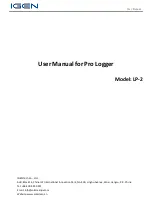
Section 8. Operation
410
Four-Wire Full-Bridge Measurement and Processing
'This program example demonstrates the measurement and processing of a four-wire resistive
'full bridge. In this example, the default measurement stored in variable X is
'deconstructed to determine the resistance of the R1 resistor, which is the variable
'resistor in most sensors that have a four-wire full-bridge as the active element.
'Declare Variables
Public
X
Public
X1
Public
R1
Public
R2 = 1000
'Resistance of fixed resistor R2
Public
R3 = 1000
'Resistance of fixed resistor R2
Public
R4 = 1000
'Resistance of fixed resistor R4
'Main Program
BeginProg
Scan
(500,mSec,1,0)
'Full Bridge Measurement:
BrFull
(X,1,mV200,U1,U11,1,2500,True,True,0,60,1.0,0.0)
X1 = ((-1 * X) / 1000) + (R3 / (R3 + R4))
R1 = (R2 * (1 - X1)) / X1
NextScan
EndProg
8.1.2.3.1 Ac Excitation
Some resistive sensors require ac excitation. Ac excitation is defined as
excitation with equal positive (+) and negative (–) duration and magnitude.
These include electrolytic tilt sensors, soil moisture blocks, water-conductivity
sensors, and wetness-sensing grids. The use of single polarity dc excitation with
these sensors can result in polarization of sensor materials and the substance
measured. Polarization may cause erroneous measurement, calibration changes,
or rapid sensor decay.
Other sensors, for example, LVDTs (linear variable differential transformers),
require ac excitation because they require inductive coupling to provide a signal.
Dc excitation in an LVDT will result in no measurement.
CRBasic bridge-measurement instructions have the option to reverse polarity to
provide ac excitation by setting the
RevEx
parameter to
True
.
Note
Take precautions against ground loops when measuring sensors
that require ac excitation. See
Ground Looping in Ionic Measurements
(p.
8.1.2.3.2 Accuracy — Resistance Measurements
Read More
Consult the following technical papers at
www.campbellsci.com/app-notes
for in-depth treatments of several topics
addressing voltage measurement quality:
• Preventing and Attacking Measurement Noise Problems
• Benefits of Input Reversal and Excitation Reversal for Voltage
Summary of Contents for CR6 Series
Page 2: ......
Page 4: ......
Page 6: ......
Page 32: ......
Page 36: ......
Page 38: ......
Page 76: ...Section 5 Overview 76 FIGURE 20 Half Bridge Wiring Example Wind Vane Potentiometer ...
Page 80: ...Section 5 Overview 80 FIGURE 23 Pulse Input Wiring Example Anemometer ...
Page 136: ......
Page 454: ...Section 8 Operation 454 FIGURE 104 Narrow Sweep High Noise ...
Page 459: ...Section 8 Operation 459 FIGURE 106 Vibrating Wire Sensor Calibration Report ...
Page 535: ...Section 8 Operation 535 8 11 2 Data Display FIGURE 121 CR1000KD Displaying Data ...
Page 537: ...Section 8 Operation 537 FIGURE 123 CR1000KD Real Time Custom ...
Page 538: ...Section 8 Operation 538 8 11 2 3 Final Storage Data FIGURE 124 CR1000KD Final Storage Data ...
Page 539: ...Section 8 Operation 539 8 11 3 Run Stop Program FIGURE 125 CR1000KD Run Stop Program ...
Page 541: ...Section 8 Operation 541 FIGURE 127 CR1000KD File Edit ...
Page 546: ......
Page 552: ......
Page 610: ...Section 11 Glossary 610 FIGURE 137 Relationships of Accuracy Precision and Resolution ...
Page 612: ......
Page 648: ......
Page 650: ......
Page 688: ......
Page 689: ......
















































